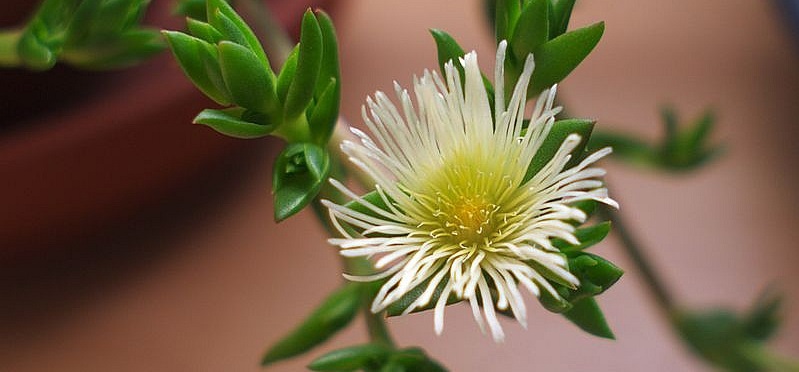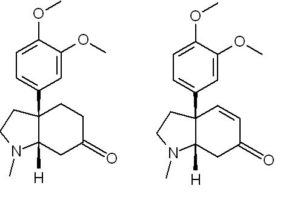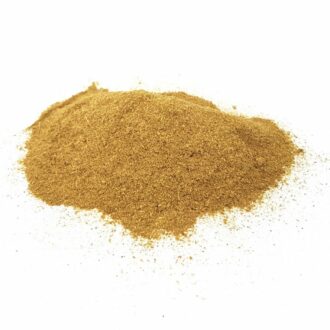Kanna 01/08/2019
Kanna, in Latin Sceletium tortuosum, is a small plant growing to a height of about 30 centimeters. It grows almost exclusively in South Africa, its cultivation is so demanding that the conditions of other areas do not suit it. It parades with beautiful flowers that can be colored white, yellow, orange or pink. For its users, however, the far more interesting parts of the plant are leaves. These are collected and dried and then used in various forms to produce desired effects.
HISTORY
Kanna has been a favorite herb in South Africa since ancient times for indigenous hunters and gatherers, who used its miraculous effects on long expeditions to sharpen the senses, improve mood and drive away hunger. It was also part of spiritual rituals and had its place in traditional healing.
For the first time, Kanna was officially described in 1662 by Dutch explorer Jan Van Riebeeck, who traveled through Africa and noticed that the tribes there chew a specific herb that helps them survive in difficult conditions. This herb was further investigated and subsequently described under the Latin name Sceletium tortuosum.
Today, Kanna is being researched by various pharmaceutical companies that investigate the effects of its alkaloids in more detail. It is believed that it could work much better than today’s chemical drugs. And even without the unpleasant side effects.

CHEMISTRY
Kanna works on the basis of SRI. The alkaloids contained - in particular Mesembrine and Mesembrenone, cause psychoactive effects precisely by binding to the serotonin receptors of our nervous system.
EFFECTS
Kanna acts as a natural antidepressant. It improves mood, relieves stress, tension and anxiety. Individuals become more friendly and open, so it’s easy for them to socialize and communicate. Kanna’s euphoric effects are also suitable for relaxation. Recent studies confirm the positive effects on concentration and attention – Kanna also acts as a nootropic.
The effects start within 10 minutes and last up to 3 hours.
PREPARATION AND DOSAGE
Extracts Global Herbs ( Ultimate, Smoke, Full Spectrum, Happy Calming, Merry Stony)
It is recommended to start with doses as low as 25mg.
The extract can be taken in almost any way – in the form of capsules, stirring in water, snuffing or putting it in your mouth and then chewing.
10:1 Extract
A suitable dose is around 150mg. The extract can be taken almost any way you like - in capsule form, by mixing in water, sniffing or putting in the mouth and then chewing.
Powder from the herb
For optimal effect , 1 - 2 grams of powder from the herb can be used. Pour about 250ml of boiling water over the powder and leave to infuse for 5-10 minutes, the powder will form a sediment at the bottom so there is no need to strain it. The drink is ready for consumption. Once used, the powder can be poured over boiling water once more.
COMBINATION
Kanna + Cannabis
When used simultaneously, Kanna and Hemp (whether CBD or THC) act synergistically, i.e. their effects complement and support each other.
Kanna + Kratom
The combination of Kanna and Kratom proves to be safe. There are no mutual negative effects at the neurobiological level as in the combination of Kanna with other antidepressant plants and drugs. On the contrary, the effects of these plants support and complement each other.
Kanna + Cacao
The synergistic effect of Kanna and Cacao is also known. Both plants act on the human endocannabinoid system and complement each other in terms of euphoric and relaxing effects. In addition, Kanna extracts have their typical “spicy cinnamon taste”, which can spice up a cocoa drink in an exotic way. Due to the light MAOI action of cacao, this combination should be considered when using high (ceremonial) doses of cocoa (50g + per dose), where the MAOI action in combination with kanna may no longer be completely pleasant.
CONTRAINDICATION
Kanna acts on the basis of SRI. It must therefore not be combined with other antidepressants and MAOIs. These are found, for example, in the plants Banisteriopsis Caapi or Passioflora incarnata. This could lead to a surge of serotonin receptors and the development of serotonin syndrome!





